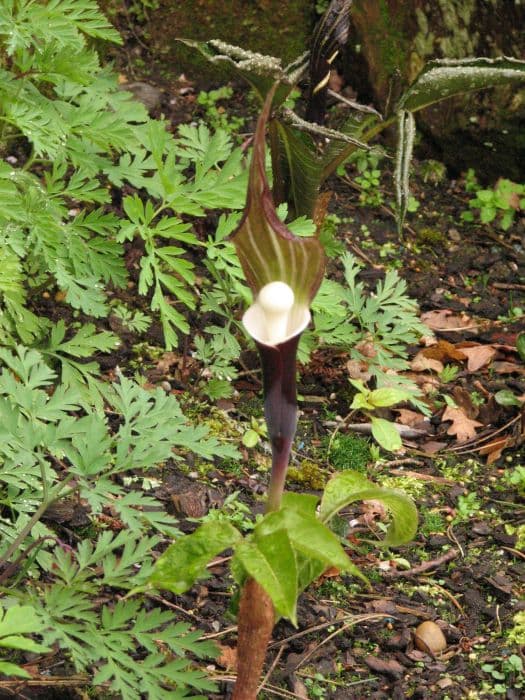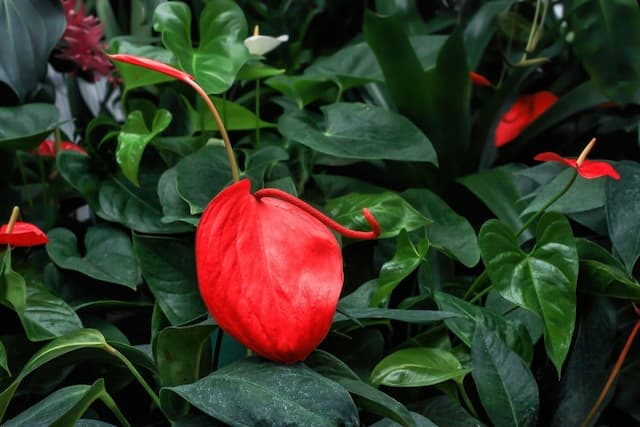Calla Lily 'Starry Night' Zantedeschia 'Starry Night' (PBR)

ABOUT
Zantedeschia 'Starry Night', commonly known as a Calla Lily, is a strikingly ornamental plant celebrated for its distinctive floral display. The flower, shaped like a flaring trumpet, which is technically a spathe, is the plant's most captivating feature—it swirls around a finger-like spadix in a graceful twist. The colors of the spathe are a spectacle to behold, with a deep purple that can appear almost black, punctuated by speckles and a brushstroke of cream or white that gives it a celestial, starry appearance. This enchanting pattern is where it gets its name, 'Starry Night'. The leaves of the Calla Lily are equally attractive. They are glossy and arrow-shaped, often with a waxy texture that adds to the plant's elegance. These leaves provide a lush backdrop, creating a full and verdant base from which the dramatic flowers rise. In contrast to the dark hues of the blooms, the foliage's lively green shade is soothing to the eye, and may sometimes feature lighter spots or streaks. 'Starry Night' is remarkable not only for its beauty but also for its ability to provide an alluring touch to any garden space or floral arrangement. It stands out with its elegant flowers that add a touch of sophistication and a burst of dark, luminous color. The plant typically blooms in the warmer months, providing a long-lasting display of its enchanting flowers.
About this plant
 Names
NamesFamily
Araceae
Synonyms
Calla Lily, Arum Lily
Common names
Zantedeschia 'Starry Night' (PBR)
 Toxicity
ToxicityTo humans
Calla Lily (Zantedeschia 'Starry Night') contains calcium oxalate crystals, which are toxic to humans when ingested. If someone chews or swallows parts of the plant, it can lead to immediate symptoms such as a burning sensation in the mouth and throat, swelling of the lips, tongue and surrounding tissue, which can lead to difficulty speaking or swallowing. Other symptoms may include nausea, vomiting, and diarrhea. In severe cases, ingesting large amounts of the plant can result in dehydration or difficulties in breathing due to swelling of the airways.
To pets
Calla Lily (Zantedeschia 'Starry Night') is toxic to pets, including cats and dogs, due to the presence of calcium oxalate crystals. Ingestion of any part of the plant can result in similar symptoms as in humans: oral irritation, intense burning and irritation of the mouth, tongue and lips, excessive drooling, vomiting, and difficulty swallowing. In severe cases, it may lead to dehydration, an obstruction in the airway due to swelling, and possibly renal failure from the body's reaction to the toxin if a significant amount is ingested.
 Characteristics
CharacteristicsLife cycle
Perennials
Foliage type
Deciduous
Color of leaves
Varies
Flower color
Cream
Height
1-2 feet (30-60 cm)
Spread
1 foot (30 cm)
Plant type
Herb
Hardiness zones
8
Native area
South Africa
Benefits
 General Benefits
General Benefits- Attractive Blooms: Features showy and distinctive spadix surrounded by a spathe, often mistaken for petals, that is appealing in gardens and as cut flowers.
- Long Blooming Season: Provides a prolonged period of interest with blooms that can last for several weeks.
- Easy to Grow: Adapts well to a variety of soil types and is relatively easy to care for, making it suitable for gardeners of all levels.
- Low Maintenance: Requires minimal pruning and is not particularly demanding, making it a convenient choice for busy gardeners.
- Versatility in Use: Can be used in beds, borders, containers, and as a statement piece due to its eye-catching flowers.
- Drought Tolerant: Once established, it can tolerate periods of drought, reducing the need for frequent watering.
- Deer Resistant: Less favored by deer, which can be beneficial in areas where deer browsing is a problem for gardens.
- Attracts Pollinators: Brings beneficial insects like bees to the garden, aiding in pollination of plants and contributing to biodiversity.
- Seasonal Interest: Provides visual interest through different seasons, especially spring and summer when in bloom.
- Color Variety: Offers various color options through different cultivars, allowing for personalization of garden color schemes.
- Compact Growth: With its relatively small size and clumping growth habit, it's suitable for gardens with limited space.
 Medical Properties
Medical PropertiesThis plant is not used for medical purposes.
 Air-purifying Qualities
Air-purifying QualitiesThis plant is not specifically known for air purifying qualities.
 Other Uses
Other Uses- Calla lilies like 'Starry Night' can be used in eco-friendly funerals as they are biodegradable and often considered a symbol of rebirth and resurrection.
- They can serve as a natural dye source, with their pigments potentially used for dyeing fabrics and materials.
- 'Starry Night' can be featured in art classes or photography for studying the intricate shapes and colors of unique flowers.
- With proper care, these plants could be grown as a part of a home science project to study hybrid plant varieties and genetics.
- These calla lilies can be used in crafting, where their dried or pressed flowers can be incorporated into paper making or bookmark creating.
- They can be employed in the construction of living walls or green installations, particularly within urban environments for aesthetic purposes.
- During thematic events or plays, 'Starry Night' may be used as a prop to enhance the setting for artistic or dramatic presentations.
- Calla lilies can figure in non-traditional plant arrangements such as submerged centerpieces for underwater-themed decorations.
- Their strong stems make them suitable for inclusion in structural floral arts, such as topiaries or flower towers.
- These plants might be used in culinary contexts as garnishes, provided they are not consumed and are clearly identified as non-edible.
Interesting Facts
 Feng Shui
Feng ShuiThe Calla Lily is not used in Feng Shui practice.
 Zodiac Sign Compitability
Zodiac Sign CompitabilityThe Calla Lily is not used in astrology practice.
 Plant Symbolism
Plant Symbolism- Rebirth and Resurrection: The 'Starry Night' calla lily, much like other lilies, often symbolizes rebirth due to its perennial nature, emerging anew each year.
- Purity and Innocence: The calla lily's striking and pure white flowers are commonly associated with innocence and purity, a symbolism often recognized in religious and wedding contexts.
- Beauty and Elegance: Calla lilies are widely admired for their sleek and graceful appearance; thus the 'Starry Night' variety is no exception, embodying beauty and sophistication.
- Commitment and Faithfulness: Given their common use in wedding ceremonies, calla lilies can represent devotion and loyalty between partners.
- Overcoming Challenges: The hardiness and resilience of the 'Starry Night' calla lily serve as a metaphor for overcoming difficulties and thriving despite challenges.
 Water
WaterCalla lilies, like the Zantedeschia 'Starry Night', prefer to be watered deeply but infrequently, allowing the top inch of soil to dry out between waterings. During the growing season, you may water approximately once a week with about 1 gallon of water per plant, depending on the climate and humidity levels. In hot, dry periods, you might have to water twice a week, but always check the soil moisture first. Reduce watering during the winter dormant period, and only provide water to prevent the soil from completely drying out.
 Light
LightThe Calla Lily 'Starry Night' thrives best in bright, indirect light. A spot that receives morning sunlight with shade in the afternoon is ideal. Avoid direct, harsh sunlight as it can scorch the leaves, and too little light can lead to poor bloom development.
 Temperature
TemperatureCalla Lilies like 'Starry Night' do well in temperatures ranging from 60 to 75 degrees Fahrenheit. They can survive in temperatures as low as 50 degrees but should not be subjected to temperatures below that point. The ideal range to encourage blooming is between 60 and 70 degrees Fahrenheit.
 Pruning
PruningCalla Lilies like 'Starry Night' should be pruned to remove spent flowers and yellowed leaves to promote growth and improve appearance. This can be done as needed throughout the growing season. The best time for major pruning is after the blooms have faded and the foliage begins to turn yellow.
 Cleaning
CleaningAs needed
 Soil
SoilThe Calla Lily 'Starry Night' prefers a well-draining soil mix rich in organic matter with a pH between 6.0 to 6.5. A mix of potting soil, peat moss, and perlite or sand will ensure adequate drainage and support healthy growth.
 Repotting
RepottingCalla Lily 'Starry Night' should be repotted every two to three years or when you notice it becoming root-bound. Spring is the best time to repot, right before the active growing season begins.
 Humidity & Misting
Humidity & MistingCalla Lily 'Starry Night' thrives in moderate to high humidity, optimally between 60% to 70%. If indoor air is dry, use a humidifier or place the pot on a water-filled pebble tray to increase surrounding humidity.
 Suitable locations
Suitable locationsIndoor
Place in bright, indirect light and keep soil moist.
Outdoor
Grow in partial shade, protect from strong winds, and keep soil moist.
Hardiness zone
8-10 USDA
 Life cycle
Life cycleThe Zantedeschia 'Starry Night', commonly known as Calla Lily, begins its life cycle as a rhizome, which, when planted in spring, will sprout into leafy growth. From the rhizome’s nodes, roots and shoots emerge, and the plant develops into a clump of large, arrow-shaped dark leaves often speckled with white. As the plant matures, it produces striking funnel-shaped flowers that may be of various colors, including the deep purple indicative of 'Starry Night', typically blooming in late spring to early summer. After flowering, the plant enters a period of dormancy, especially in regions with cooler winters. During dormancy, the foliage dies back, and the plant conserves energy within its rhizome. Upon the return of conducive growing conditions, such as warmer temperatures and longer daylight hours, the cycle begins anew with fresh sprouts in the following spring.
 Propogation
PropogationPropogation time
Spring-Early Summer
The most popular method of propagating Zantedeschia 'Starry Night', commonly known as Calla Lily, involves dividing the rhizomes. This process is typically carried out in late winter or early spring before the plant begins its active growth period. To propagate, the plant should be carefully lifted from the soil and the rhizomes should be divided by hand or with a clean, sharp knife. Each division should have at least one growth point or eye. After division, the separated rhizomes can be replanted in well-draining soil, ensuring the growth points are just above the soil surface. Water the newly planted rhizomes thoroughly to establish them. This straightforward vegetative method maintains the characteristics of the parent plant and ensures a quicker bloom than propagation by seed.









